System and method for controlling the size and/or distribution of catalyst nanoparticles for nanostructure growth
a nanoparticle and catalyst technology, applied in the field of systems, can solve the problems of inability to provide controllable and predictable carbon nanotube growth in terms of size and density, prior proposed schemes are difficult to integrate into conventional semiconductor device fabrication methodologies, and it is inconceivable that iron catalyst particles will be uniformly distributed across a wafer without further aid
- Summary
- Abstract
- Description
- Claims
- Application Information
AI Technical Summary
Benefits of technology
Problems solved by technology
Method used
Image
Examples
Embodiment Construction
[0031]It is helpful at the outset hereof to provide an overview of some of the terminology used herein. The following overview of terminology will be a simple review for one of ordinary skill in the art, as the terminology used herein is not inconsistent with how it is commonly used in the art.
[0032]The term “polymer” refers to a chemical compound or mixture of compounds formed by polymerization and consisting essentially of repeating structural units. The basic chemical “units” that are used in building a polymer are referred to as “repeat units.” A polymer may have a large number of repeat units or a polymer may have relatively few repeat units, in which case the polymer is often referred to as an “oligomer.”
[0033]When a polymer is made by linking only one type of repeat unit together, it is referred to as a “homopolymer.” When two (or more) different types of repeat units are joined in the same polymer chain, the polymer is called a “copolymer.” In copolymers, the different types...
PUM
| Property | Measurement | Unit |
|---|---|---|
| diameters | aaaaa | aaaaa |
| size | aaaaa | aaaaa |
| size | aaaaa | aaaaa |
Abstract
Description
Claims
Application Information
 Login to View More
Login to View More - R&D
- Intellectual Property
- Life Sciences
- Materials
- Tech Scout
- Unparalleled Data Quality
- Higher Quality Content
- 60% Fewer Hallucinations
Browse by: Latest US Patents, China's latest patents, Technical Efficacy Thesaurus, Application Domain, Technology Topic, Popular Technical Reports.
© 2025 PatSnap. All rights reserved.Legal|Privacy policy|Modern Slavery Act Transparency Statement|Sitemap|About US| Contact US: help@patsnap.com



